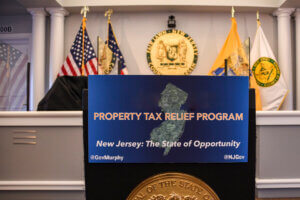With school back in session, the iconic yellow school bus has returned to Garden State roadways. Most residents believe that the state’s buses are operated in a safe manner, but some express concern about driver training and vehicle maintenance, according to the latest Monmouth University/Gannett New Jersey Poll .
About 1-in-7 New Jerseyans feel that all (3%) or most (11%) school buses on the road today have serious mechanical or maintenance problems. Another 35% feel that some school buses have these problems, while just over 1-in-3 say that only a few (31%) or none (5%) of the buses operating today are in need of serious repair.
On the other hand, 2-in-3 New Jerseyans say the state’s school buses are driven in a safe manner all (14%) or most (54%) of the time. Another 24% say they see buses driven safely just some of the time, and few say they rarely (2%) or never (1%) see school buses driven safely.
New Jerseyans feel that school bus drivers receive enough training to deal with traffic and road hazards by a 2-to-1 margin – 50% agree and 27% disagree, while another 23% have no opinion. Residents are somewhat less certain that these drivers receive enough training to deal with distractions caused by their student riders – 40% feel they do receive enough training in this area and 36% disagree, while 24% express no opinion.
New Jerseyans are also divided on whether driver background checks are performed properly – 44% say they are confident this is done properly compared to 37% who disagree, and 20% have no opinion.
“Many New Jerseyans express confidence in our school bus system. However, we also found sizable numbers who are concerned about vehicle maintenance and driver training issues,” said Patrick Murray, director of the Monmouth University Polling Institute.
Importantly, the poll also found that parents of children who take buses to school are less likely than other residents to feel that drivers are adequately trained in road hazards (42% agree to 35% disagree, and 23% no opinion) and dealing with distractions (32% agree to 44% disagree, and 24% no opinion).
“One of the more intriguing findings of the survey is that nearly one in four parents of bus riders have no opinion on whether these drivers are properly trained. This seems like a large number of parents who are unsure about the safety of their children when they put them on that bus,” added Murray.
Some school buses are operated by school districts, while other districts obtain transportation services from private companies. Nearly half of state residents (47%) feel that both services are equally safe. Among the remainder, 27% say that buses operated by school districts are probably safer, compared to 13% who give the safety nod to private bus companies.
The poll also found that residents are split on whether New Jersey school buses should be required to install shoulder belts. Currently, the state’s school bus fleet must have lap belts for students. About half (49%) say that shoulder belts should also be required even if they significantly increase the cost of the bus, compared to 42% who feel that the current lap belt requirement is sufficient. Parents of children who ride school buses are more likely to prefer making shoulder belts mandatory by a 54% to 41% margin.
The Monmouth University/Gannett New Jersey Poll was conducted by telephone with 1,004 New Jersey adults from July 17 to 21, 2008. This sample has a margin of error of ± 3.1 percent. The poll was conducted by the Monmouth University Polling Institute and originally published by the Gannett New Jersey newspaper group (Asbury Park Press, Courier-Post, Courier News, Daily Journal, Daily Record, and Home News Tribune).
DATA TABLES
The questions referred to in this release are as follows:
(* Some columns may not add to 100% due to rounding.)
1. Overall, do you think the school buses you see on the road are driven in a safe manner all of the time, most of the time, some of the time, rarely, or never?
|
TOTAL | PARENT | RIDES SCHOOL BUS |
COMMUNITY TYPE | ||||||
|
Yes |
No |
Urban | Town/ Suburb |
Growing | |||||
| All of the time | 14% | 8% | 17% | 10% | 22% | 12% | 14% | ||
| Most of the time | 54% | 59% | 53% | 54% | 49% | 57% | 54% | ||
| Some of the time | 24% | 27% | 22% | 33% | 23% | 24% | 24% | ||
| Rarely | 2% | 2% | 2% | 3% | 1% | 3% | 2% | ||
| Never | 1% | 1% | 1% | 1% | 1% | 1% | 1% | ||
| (VOL) Don’t know | 5% | 2% | 5% | 0% | 4% | 4% | 5% | ||
| Unwtd N |
1004 | 250 | 745 | 96 | 138 | 399 |
413 | ||
2. Do you agree or disagree with the following statements: [ITEMS WERE ROTATED]
School bus drivers receive enough training to deal with traffic and road hazards
|
TOTAL | PARENT | RIDES SCHOOL BUS |
COMMUNITY TYPE | ||||||
|
Yes |
No |
Urban | Town/ Suburb |
Growing | |||||
| Agree | 50% | 46% | 52% | 42% | 43% | 50% | 51% | ||
| Disagree | 27% | 29% | 25% | 35% | 37% | 27% | 24% | ||
| (VOL) Don’t know | 23% | 24% | 23% | 23% | 20% | 23% | 26% | ||
| Unwtd N |
1004 | 250 | 745 | 96 | 138 | 399 |
413 | ||
School bus drivers receive enough training to deal with distractions caused by children on the bus
|
TOTAL | PARENT | RIDES SCHOOL BUS |
COMMUNITY TYPE | ||||||
|
Yes |
No |
Urban | Town/ Suburb |
Growing | |||||
| Agree | 40% | 34% | 42% | 32% | 44% | 38% | 38% | ||
| Disagree | 36% | 40% | 35% | 44% | 42% | 34% | 38% | ||
| (VOL) Don’t know | 24% | 26% | 23% | 24% | 14% | 28% | 24% | ||
| Unwtd N |
1004 | 250 | 745 | 96 | 138 | 399 |
413 | ||
I am confident that proper background checks are performed for school bus drivers
|
TOTAL | PARENT | RIDES SCHOOL BUS |
COMMUNITY TYPE | ||||||
|
Yes |
No |
Urban | Town/ Suburb |
Growing | |||||
| Agree | 44% | 40% | 45% | 41% | 45% | 41% | 42% | ||
| Disagree | 37% | 41% | 36% | 42% | 38% | 38% | 39% | ||
| (VOL) Don’t know | 20% | 19% | 20% | 17% | 17% | 21% | 19% | ||
| Unwtd N | 1004 | 250 | 745 | 96 | 138 | 399 | 413 | ||
3. How many school buses being driven on the road do you think have serious mechanical or maintenance problems – all, most, some, just a few, or none?
|
TOTAL | PARENT | RIDES SCHOOL BUS |
COMMUNITY TYPE | ||||||
|
Yes |
No |
Urban | Town/ Suburb |
Growing | |||||
| All | 3% | 2% | 3% | 1% | 4% | 3% | 3% | ||
| Most | 11% | 13% | 10% | 13% | 16% | 10% | 10% | ||
| Some | 35% | 42% | 32% | 49% | 28% | 36% | 37% | ||
| Just a few | 31% | 32% | 31% | 29% | 29% | 32% | 31% | ||
| None | 5% | 3% | 6% | 2% | 13% | 3% | 5% | ||
| (VOL) Don’t know | 15% | 8% | 17% | 7% | 11% | 16% | 15% | ||
| Unwtd N |
1004 | 250 | 745 | 96 | 138 | 399 |
413 | ||
4. Which do you think are probably safer – school buses operated by school districts, or school buses operated by private companies, or are both equally safe?
|
TOTAL | PARENT | RIDES SCHOOL BUS |
COMMUNITY TYPE | ||||||
|
Yes |
No |
Urban | Town/ Suburb |
Growing | |||||
| School districts safer | 27% | 27% | 27% | 23% | 26% | 26% | 28% | ||
| Private companies safer | 13% | 18% | 12% | 26% | 10% | 16% | 12% | ||
| Both equally safe | 47% | 44% | 48% | 43% | 52% | 45% | 47% | ||
| (VOL) Neither are safe | 1% | 1% | 1% | 0% | 2% | 2% | 0% | ||
| (VOL) Don’t know | 11% | 11% | 12% | 9% | 10% | 11% | 13% | ||
| Unwtd N |
1004 | 250 | 745 | 96 | 138 | 399 |
413 | ||
5. New Jersey school buses are currently required to have lap belts. Should they also be required to have shoulder belts even if it significantly increases the cost of the bus, or are lap belts enough?
|
TOTAL | PARENT | RIDES SCHOOL BUS |
COMMUNITY TYPE | ||||||
|
Yes |
No |
Urban | Town/ Suburb |
Growing | |||||
| Require shoulder belts | 49% | 52% | 48% | 54% | 56% | 50% | 45% | ||
| Lap belts are enough | 42% | 39% | 43% | 41% | 35% | 41% | 47% | ||
| (VOL) Don’t know | 9% | 10% | 8% | 5% | 9% | 9% | 8% | ||
| Unwtd N |
1004 | 250 | 745 | 96 | 138 | 399 |
413 | ||
The Monmouth University/Gannett New Jersey Poll was conducted and analyzed by the Monmouth University Polling Institute research staff. The telephone interviews were collected by Braun Research on July 17-21, 2008 with a statewide random sample of 1,004 adult residents. For results based on the total sample, one can say with 95% confidence that the error attributable to sampling has a maximum margin of plus or minus 3.1 percentage points. Sampling error increases as the sample size decreases, so statements based on various population subgroups, such as separate figures reported by gender or party identification, are subject to more error than are statements based on the total sample. In addition to sampling error, one should bear in mind that question wording and practical difficulties in conducting surveys can introduce error or bias into the findings of opinion polls.
It is the Monmouth University Polling Institute’s policy to conduct surveys of all adult New Jersey residents, including voters and non-voters, on issues which affect the state. Specific voter surveys are conducted when appropriate during election cycles.
Click on pdf file link below for full methodology and results by key demographic groups.




